Test of Honour is a Samurai skirmish game pitched at 5-20 models set in Sengoku era Japan, the golden age of samurai warfare.
It is not a mass battle game, but more akin to a samurai movie game. You can scale the game up but would never approach something that simulates the mass battles of something like Shogun Total War, or Black Powder.
That’s a good thing, as you can create little themed bands of fighters (bandits, ronin, ninja, onna-bugeisha, scouts ahead of a larger force, monks, a peasant rebellion, etc) and fight out games defending a village, capturing a bridge, ambushing a trade caravan, assassinating a local lord, and that’s a good thing and makes for a quicker, narrative focused game.
As Ghost of Tsushima piques people’s interest in the period (though Shogun Total War, Samurai films and popular culture wasn’t exactly leaving it uncovered before), it’s actually a great time to get into Samurai skirmish gaming.
You can play out your favourite samurai movies (or murder bandit camps) on the table top, and collect and paint small and characterful forces.
In this article I’ll cover the history of the game, how the game works and how to build forces for the game, and because people might need it, explanations of where to get minis and the rules you need for them, and what themed forces there are.
I talk a lot about different mini ranges when I talk about factions, so to make it easy I’m just going to link them here so it’s easy for you.
Grey for Now Games – the rules and a bunch of cool figures
Bad Squiddo – Onna-Bugeisha and also a Samurai Cat and Dog
Northstar’s Ronin range – themed boxes of figures
Footsore – lots of Ashiguru and plenty of single figure Samurai
The History
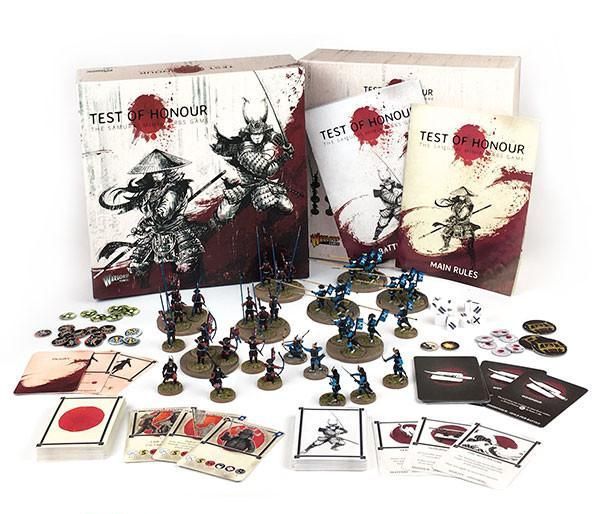
The first edition of this game was produced by Warlord Games in 2017, using the Wargames Factory samurai plastics (the Samurai, Samurai Cavalry, Ashiguru and Ashiguru Missile Troops sprues that Wargames Factory had produced) in both the core set and a set of expansions launched at the same time. In each of these sets, and with the core set, there was a single metal miniature (and sometimes some metal heads) that were the special characters. Each expansion added more cards and troop types to the game, and gave more quest and skill cards.
While I liked it, looking at it dispassionately there were issues with the sculpting quality of the metal models in the first wave of releases, and the Wargames Factory plastics could at best be described as challenging in terms of assembly. People being less charitable would describe them as painful.
This led towards a somewhat agnostic approach to minis, and a number of players dipped into Bushido, Perry miniatures, the old and OOP Legend of the Five Rings miniatures game, Bad Squiddo and some people even purchased the Dixon models (which I would say are some of the weaker sculpts for the era but some people like them).
The miniature quality took a huge jump forward in quality with the all metal expansion sets produced in the second wave, which were the Bandits and Brigands, Ninja, Onna Bugeisha and Sohei Monks. These were all great sculpts and the Bandits in particular were straight out of a Samurai movie. Wako pirates were next in line but not done as Andy Hobday and Warlord parted ways. Test of Honour was moved towards a second edition with Grey for Now Games.
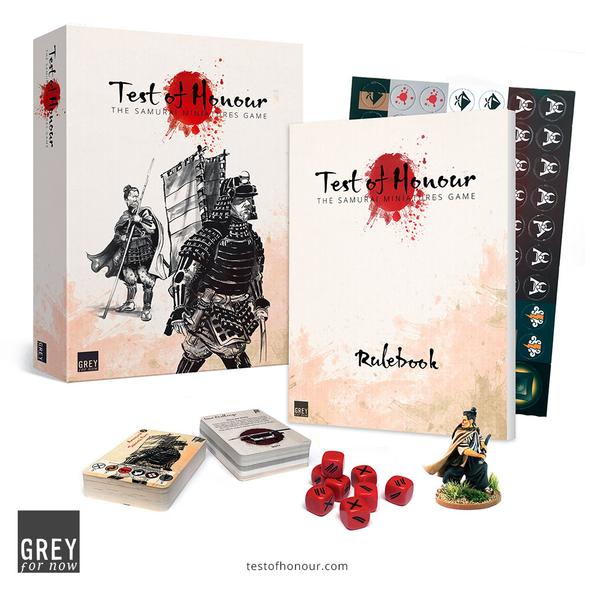
Footsore Miniatures produced a Samurai range, with Ashigaru and a large number of individual Samurai. Grey for Now Games produced themed boxed sets – Seven Ronin (who aren’t Samurai for legal reasons), Unexpected Allies (a box of single figure characters to add to any faction or play as their own rag tag band), Ashigaru Scouts and Sohei Monks. Grey For Now Games have also released free online card packs for three of the North Star Samurai sets, Ronin, Bandits and Sohei Monks.
I played a lot of the first edition rules set, and it was a solid and fun set of rules. 24 points was the standard full sized force, and the only issue with the metal miniatures was that they boxed sets tended to top out around 15 points, meaning you needed an additional hero and another couple of groups of troops to field a full sized force. I put together a force of desperados using the Bandits boxed set reinforced with a couple of groups of Ronin made of old LOT5R models.
However 1st edition was not perfect. There were cards scattered across different expansions, and people found themselves buying piles of the same somewhat painful to assemble plastic figures that just went straight on piles of shame. It led to a situation, like X-wing, where some players were buying figures to get cards.
In terms of rules, these were split across the core set and the 2nd wave expansions, which all had booklets with additional rules and a campaign. These were needed, adding new scenarios and rules like darkness for night fights. However this split the player base a little as people had different sets of rules to refer to and the rules booklets, while nowhere near as heavy as a 40k codex, needed to be remembered when you went to play.
From a rules perspective the player base were unhappy about the ineffectiveness of cavalry and muskets, but the rules had stood up pretty well to contact with players. There were no glaring problems or issues with balance that made playing certain factions pointless, or made playing against factions unfun.
The Game
In Test of Honour you play on at least a 3 foot by 3 foot table. You need a bit of terrain, and the more the better, but can use generic terrain you would use for every game, such as rivers, marshes, woods and hills. The table will look better with some era specific terrain, and there are plenty of resin and mdf items available which I will cover in a later article.
You can play 15 point games, possibly with as few as 5 models, but once you get to 24 point games you can reliably field 3 Samurai, a couple of groups of infantry (Ashigaru for example, and in bases of 3) and 2-3 single models.
What you can do is theme your force around a boxed set, or around something like a patrol of Ashigaru led by a Samurai or two. The metal boxed sets produced by Grey for Now games (Ashigaru Scouts, Seven Ronin or Sohei Monks) give you a themed force, that you can either use as a core or add some other models – Bandits, Ashigaru , Unarmoured Samurai, etc etc. A Samurai Leader would be 6 or seven points, a Hero 4 or 5, groups 2 or 3 and individual models between 1 and 3 points depending on their abilities. Second edition has added upgrade cards that can be taken to improve models or groups of figures, and give more flexibility in a force.
The non-samurai single figures often have a special ability that benefits other peasant models (such as a free charge or shooting action) and thus are often used to buff groups. This gives you sergeants or sub characters to further add character to your force, and an alternative to the beat sticks that are samurai heroes.
For instance the Unlikely Allies box from Grey for Now Games gives you eight of these supporting characters.
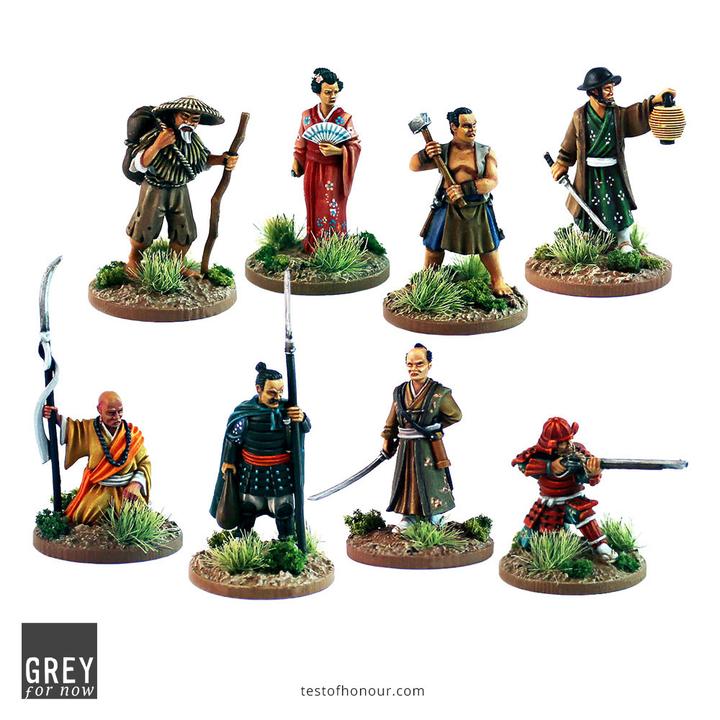
The game is alternating activation, where players take turns drawing counters from a bag to activate troops or cause events to happen. There are Samurai, Peasant and Fate counters, and if you draw a Samurai or Ashigaru and have no models of that type left to activate, then you give the counter to your opponent and they activate one of their models. The bag contains a counter for each activation. Peasants activate once, samurai heroes activate twice, and samurai leaders three times. This means Samurai can move more than once or fight more than once a turn, and can’t be as easily pinned as groups of peasants by missile fire. Drawing a Fate counter lets you draw a fate card, giving you a card that can improve one of your samurai with equipment or a skill.
Combat is fairly fast paced, with you having to pass a test of skill to hit (rolling 3 swords on the custom dice, or 5 swords to score a critical success). The target then Evades if it hasn’t taken it’s action (meaning missile fire and attacks can be used to suppress enemy models and pin them down and samurai can launch follow up attacks to chop their way through models that have already tried to evade) and if it fails to evade a test of strength is made (with some weapons rolling set dice, like a teppo with four dice and a bow two, and most weapons rolling the wielders strength, again favouring samurai with four or five dice).
Action economy becomes important as standard peasants only have one action (shoot/fight/charge/avoid/cautious move/get up/reload) and if you can draw out avoid actions through shooting you can pin models in place, and with samurai reduce the number of actions they have to try and meatgrinder their way through your force. This made Sergeants of Archery very popular, as they could give a bow group near them another shooting action. If you are attacked (and they hit you) you have to take an Avoid action if you have an action remaining, so missile troops are really useful for suppressing the enemy at key points. It also means you have to make use of cover and maneuvre to not take missile fire and get pinned down in the open. It also makes each action tense because you don’t know if your opponent is going to try to suppress one of your models or groups or not, or if your samurai charging across open ground will be stopped by missile fire because your opponent might not draw the counter they need to shoot.
Typically games involve a turn or two of manoeuvre and skirmishing, with occasional lucky missile hits taking out a key model, and then Samurai and groups push forward to either engage in single combats or try to trap and kill enemies.
As the turn ends when the 3rd fate token is drawn, this adds an element of risk to holding back with key models, and adds another layer of decision making for players as the Tiffin card does in Sharp Practice. Do you delay and risk not getting the action you need, or take the chance and go now?
I found the system to be fun and fairly quick to play at 15-24 points, and enjoyed the thematic and collecting part of the game. Factions are not so large as to take a long time to paint, but are big enough to be impressive to see put together. I would compare it to infinity in terms of game size, though as minis often have similar schemes, it takes less time to paint up.
How to Start
If you are starting the game from scratch there are two things to do, pick up the core rules and decide on a theme for the force you want to collect. As ever with historicals you may wish to collect two factions that are natural opponents (English and French Napoleonics, Crusaders and Saracens, Scots and other Scots). I went with Bandits as my first faction, due to the range and niceness of the models, and waited for Onna-Bugeisha to come out so that I could play bandits vs a villages defenders.
A generic samurai plus ashigaru force is good for learning the game, and can be used as reinforcements for many other factions.
There are a number of manufacturers available, as listed at the start of the article, and the ones I’d most highly recommend are Grey for Now Games (who make the game and do thematic sets), Footsore, Warlord Games and Perry Miniatures.
For some themes you will need additional card packs (as these were covered in the 1st edition and all the cards from that edition have been updated and made available as separate card packs from Grey For Now Games).
Possible Army Themes
You can theme your force (so why wouldn’t you?), but what themes can you go with?
Samurai and Ashigaru
You can do this with the Warlord plastics or Perry and Footsore miniatures. You can put together a full force with the cards within the core rules, and not have to buy any additional cards. However there are additional cards in the Clan Forces set for Daimyo’s retinue and mounted samurai, which gives you the option to include mounted models. There is also a Veteran Ashigaru set available direct from Grey For Now Games, and free Ashigaru cards for Ashigaru armed with Naginatas, Kanabos and Katanas.
If you are building the force, pick a couple of Samurai character models that you like and want to paint, and then pick out some Ashigaru and other single figures to support them. It lets you build a little narrative story around a samurai and their Ashigaru troops, a scouting or raiding party, or any sort of samurai and their retinue out on a mission.
Footsore do a range of metal Ashigaru and a large variety of Samurai figures in with and without armour. Perry similarly do a large range of figures that are nice as well.
Ronin
There are cards available for free on the Grey For Now games website to support the North Star Ronin pack. There are more Ronin cards in the Clan Forces card pack, and the Seven Ronin set from Grey for Now Games.
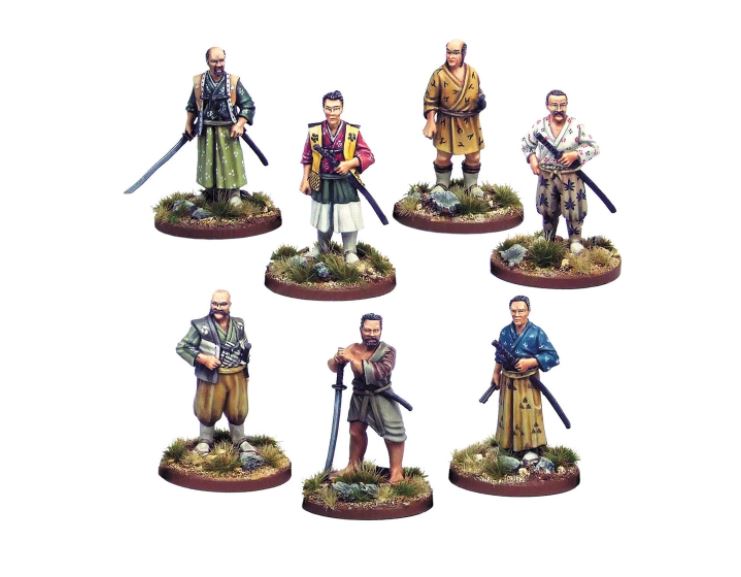
Going with Ronin gives you the chance to have a force of individuals, with no ‘uniform’ scheme where every model is a character. It lets you go with a disparate force, often of unarmoured ronin, though North Star do a pack of ronin with armour.
Given the prevalence of Ronin in cinema, it’s a tempting choice. It means picking your favourite models from a few manufacturers, and going from there.
Ninja
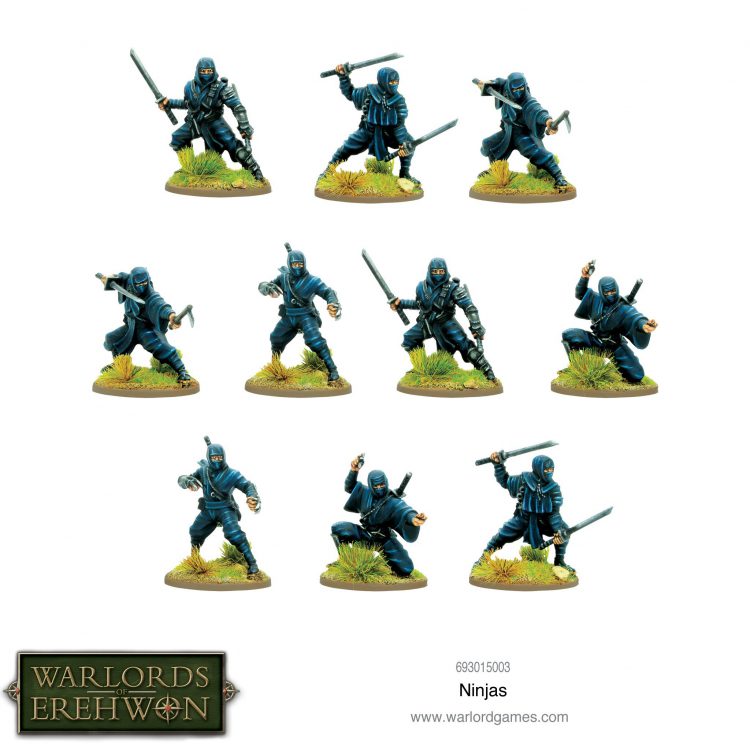
A staple of movies, and there are good miniature ranges available from Perry Miniatures and Warlord Games. Again the cards are in the Clan Forces card pack.
Ninja play differently due to being equipped with throwing weapons.
I don’t need to sell you on Ninjas, even though there isn’t a Chris Farley Beverley Hills Ninja mini as of this time.
Onna-Bugeisha
A popular faction (again from the Clan forces pack) with non-armoured models available from Warlord Games and armoured models available from Bad Squiddo. The Bad Squiddo models are a little shorter than the Warlord ones, but at the moment only the archers and banner bearer are available from Warlord. Footsore do a single armoured figure with naginata.

Onna Bugeisha were a feature on the battlefield, and in protecting clan territories. They’re a characterful force, and the unarmoured models are a good canvas for bright colours and intricate designs if you have the painting skill. Like most women’s history, it’s been glossed over (see most of recorded history for details on this) but we know enough that Onna-Bugeisha were fielded in some battles of the period, and were often armed with naginata or bows. The demure Japanese ladies of the period seems to be a bit of a fiction, in the same way people think of Victorians as being uptight and puritanical instead of the drugged up sex weirds that they historically were.
There are some models without cards, like the Venerable Onna-Bugeisha who is a pipe smoking granny with a Naginata and a baby carrier. If you are reading this Annie, you know what you must do.
Cavalry Forces
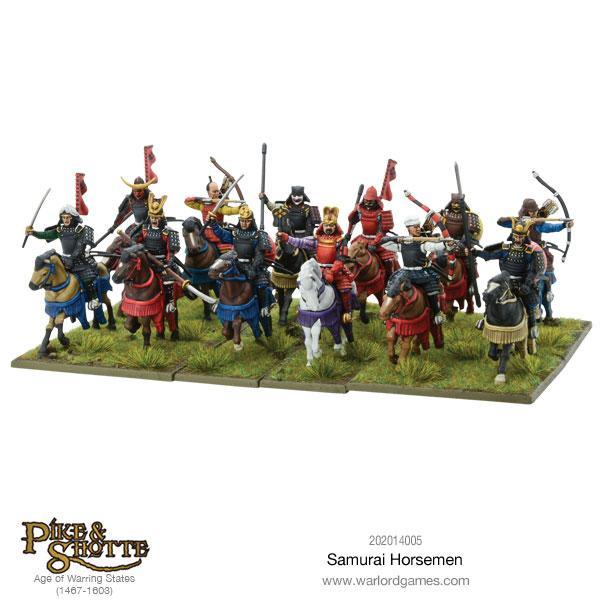
The last faction from the Clan forces card pack, this gives a mounted force of four or five figures. The changes in 2nd edition make cavalry more mobile and more effective. Adding a cavalry figure to a band gives you the ability to get across the board quickly.
Probably the lowest model count band, and you can get a full force from a single box of Samurai cavalry available from Warlord (and can build all the options possible for a cavalry force).
The Samurai cavalry plastics are actually the best of the former Wargames Factory plastics and I’ve included a picture above from the Warlord site to demonstrate this. A £20 set gives you more than everything you need.
Bandits
I would highly recommend the Warlord games bandit box, which is ten individual sculpts. Northstar do a bandit box as well, again of individual sculpts.
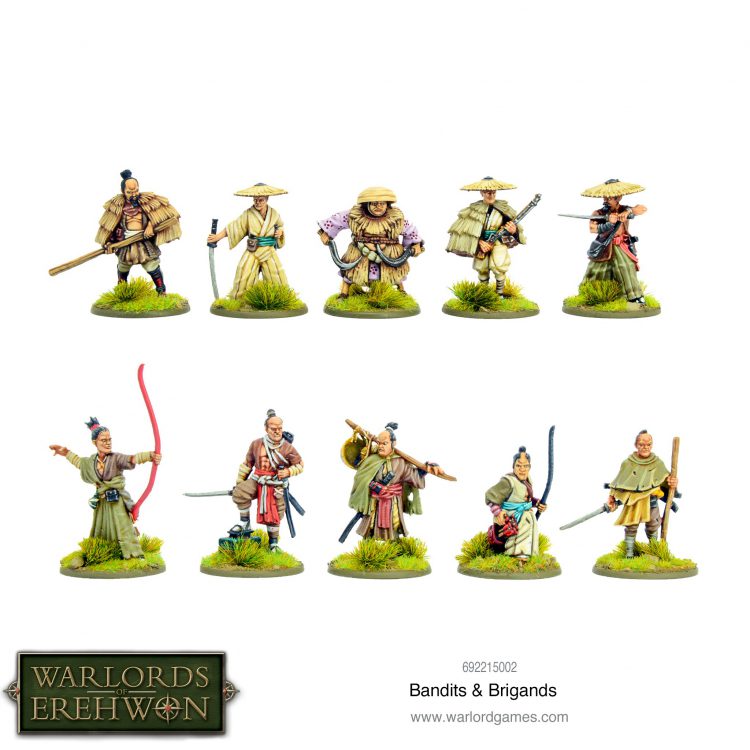
There are cards for free on the Grey for Now site, and cards for the Warlord miniatures in the Enemy Forces card pack.
This is another force that is all character figures, and where you can experiment with schemes. Also the Warlord figures have some hats, and that’s where it’s at.
Sohei Monks
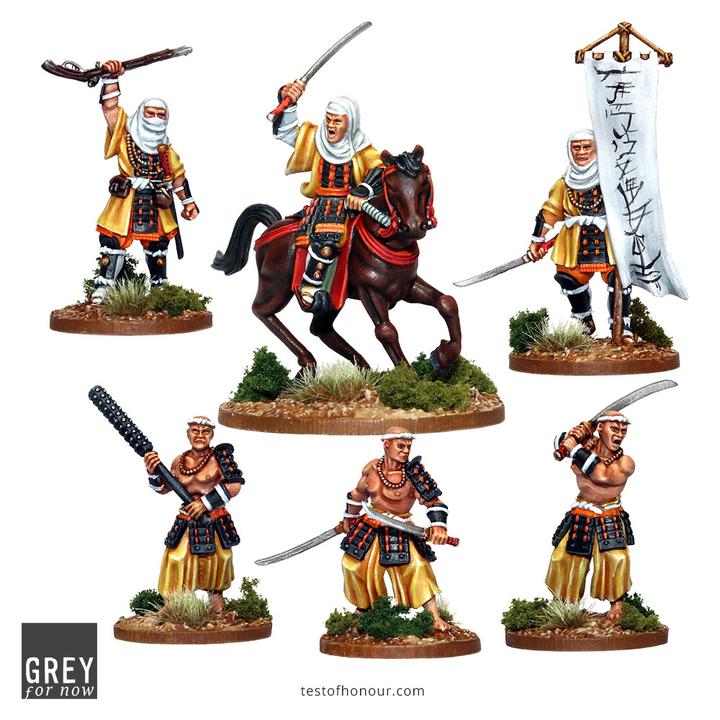
With Ikko-Ikki coming at some point from Grey for Now Games, and the latest Sohei monk release starting to arrive on people’s doormats, warrior monks are going to be flavour of the month for a while. There miniatures for monks available from Warlord, Northstar, Perry Miniatures and Grey for Now Games, they are definitely a popular choice. Perry do Ikko-Ikki as well, and Paupers or Renegades from the Enemy Forces pack would be good for representing Ikko-Ikki.
Peasant rebellions against the oppressive samurai are both characterful, diverse in terms of minis (monks, ikko-ikki, peasants, maybe some bandit or brigand figures) and pretty good in terms of the game. They’re also pretty much the closest to definite good guys you get in the period, as historically samurai weren’t a great bunch of people.
I’ve got a pile of the Warlord Sohei, and look forward to adding the Grey for Now Games Sohei to them.
Paupers, Renegades and Masked Men
These factions can be used for peasant forces, Ikko-Ikki, mercenaries, ne’er do wells, etc. Warlord have a Chobei figure in their Samurai Heroes box, and the box itself has some good single figures.
These guys are good as stand ins for other things. Want to do Wako pirates? Might look at these cards. They’re all in the Enemy Forces card pack, and these were all plastic with metal character and heads sets in the first wave of releases from Warlord. Grey for Now have updated and reissued the cards to keep these players happy.
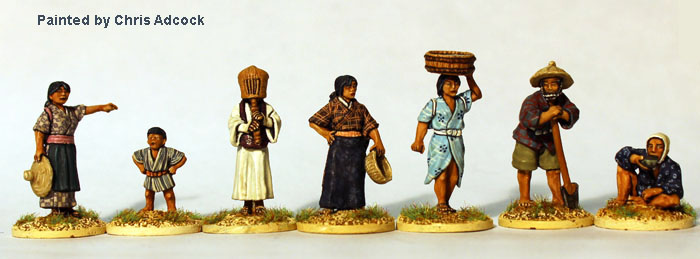
Other forces
The limit is pretty much your imagination. Warlord have started doing Japanese fantasy figures (Tengu and Oni Ogres) and have released some more Samurai figures (Daimyo and his bannermen which gives you five elite samurai figures).
I’m hoping that Warlord reissue more of their metals for Test of Honour, as there are some Onna-Bugeisha and Sohei monks that haven’t been reboxed, and that Grey for Now Games do more free card downloads for Northstar Ronin packs, as there are Chinese and Korean packs which haven’t yet had rules.
However this is your force. If you want to do a pack of Ronin hired to defend a small village, you can. If you want to do a disgraced samurai and his retainers pursuing revenge, you can. It’s your story to tell.
The Future
Grey for Now Games are continuing to support the game, and they are producing an expansion book called Sengoku to give a lot more detail on clan forces, as well as more rules and scenarios. They are working on Ikko-Ikki and more Ashigaru figures.
The game is actively supported and miniature agnostic, doesn’t require a big investment while giving you enough of a sandbox to play in that you can go a bit crazy with what you collect. I’d recommend it, and it’s my guilty pleasure in the way Necromunda is for a lot of people with lots of small factions to collect – you can go a bit crazy about the terrain as well.
Editor’s note: this article contains affiliate links. These have been labelled appropriately where they are included. For more, please see our affiliate links policy.


